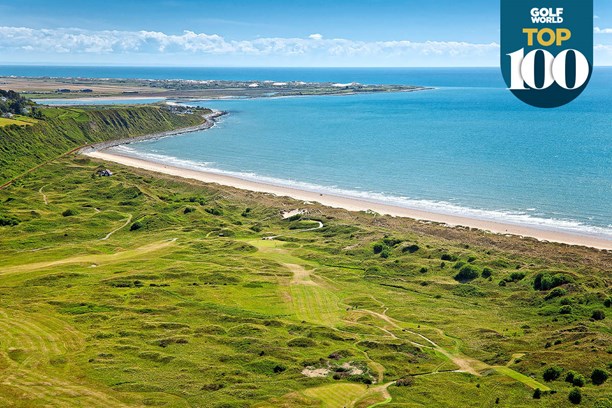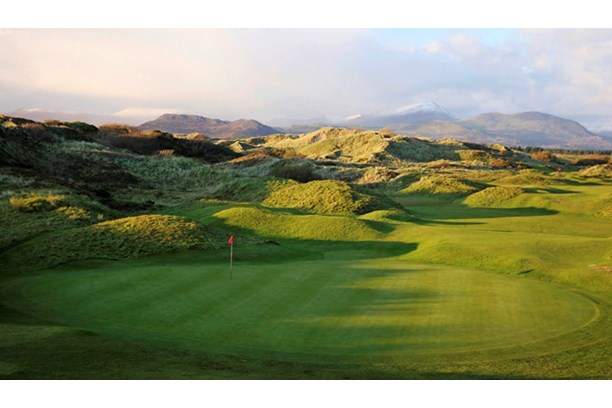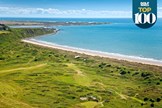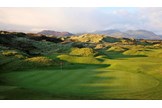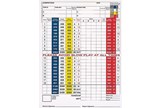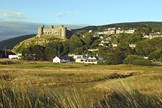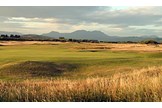Royal St David’s Golf Club
Last updated:
What we say
Royal St David’s is probably the world’s hardest par 69 golf course, and is certainly one of the best.
There are distinct phases to a visit to Royal St David’s Golf Club. The initial experience is laced with intrigue and anticipation, emotions borne from a memorable arrival in the town of Harlech.
Once on the links, your sentiments are more prosaic, cultivated by the challenge of a course touted as the world’s toughest par 69. It may feel by now a cliched description, but it is founded in accuracy.
It’s almost as if St David’s seduces you into relaxed complacency, only to bloody your nose and make off with your wallet.
RELATED: Aberdovey Golf Club review
The act of reading this article means you now have no excuse for being hijacked by her; yet first glimpse of this delicious linksland will still likely encourage some to fancy their chances with this relatively short exam.
Most of Harlech is wedged seemingly precariously into a steep hillside overlooking the Gwynedd coastline and it is into this lofty location that you enter the town within Snowdonia National Park, picking your way along the kind of twisting coast road you only ever seem to travel along when homing in on a world-class links. It is from here that you first catch a glance of the course, eliciting teenage-like excitement at glimpses between gaps in the hillside houses of the stellar linksland way down below.
Golf World Top 100: Best Golf Courses & Resorts
There then becomes an impatient urgency to your journey as you weave down the narrow lanes – including Ffordd Pen Llech, the UK’s steepest public road by virtue of its 40 per cent gradient – that is akin to a descent in the Alps.
If you can avert your eyes from the ribbons of sandy turf that snake between pyramid dunes you will likely notice Harlech Castle. It is an imposing sight, dating back to 1283 and was once captured by Welsh revolutionary Owain Glyndwr before being regained by the army of Henry Tudor. Its bloody history only adds to the romance of the setting.
Anchored atop a spur of rock, the castle’s towering location is at once intimidating and puzzling, given it is half a mile from the sea. In fact, when it was built the Irish Sea lapped its foundations and it is due to changes in geology that it now finds itself inland.
It is on the land that was left behind by the retreating sea that the links of Royal St David’s sits.
Your journey here – the glimpses of the links, the quirky descent along steepling lanes, the domineering historic castle – combine to make this a spectacular arrival by any measure; it stands comparison with those evocative approaches at (for differing reasons) Royal Portrush, St Andrews Old and Notts (Hollinwell) to name but three.
RELATED: Anglesey Golf Club
There is actually another route to the golf club, but while it lacks the drama of the winding lanes, it can match the romance and marginally surpass it in convenience. Between the golf club car park and the clubhouse is the railway line from which for decades golfers have alighted with clubs on their back.
The track links St David’s and Aberdovey and a wonderful day can be enjoyed by playing both and using the train for transport and the dormie house for digs.
Aberdovey was born first, in 1892, but within two years it had an illustrious neighbour up the west Wales of coast as the first of the ‘boom’ years in golf witnessed the game extending beyond Scotland.
Harold Finch-Hatton, son of the Earl of Winchilsea and Nottingham and William Henry More, then Crown Agent for Wales, were the men with the ambition and foresight to establish a links in Harlech. Finch-Hatton convinced More of the idyllic nature of the newly-revealed land for golf and the latter – later to become secretary – quickly grasped the economic benefits of the venture.
In addition to choosing an advantageous site for their course, they also selected a clever name for their club. Taking the country’s patron saint for its name, just as esteemed counterparts had done in England and Scotland, was likely to be brilliant rather than fortuitous. Either way, it has proved valuable marketing ever since.
The sagacious name, the prime linksland and the convenient railway line resulted in a buzz quickly surrounding St David’s that it has maintained ever since
Edward VII bestowed ‘royal’ status in 1908 while the club’s honours board bears the names of five Open champions and a Masters champion as the course played host to events ranging from Home Internationals to the Seniors Amateur and five European Seniors Tour events to a Ladies European Tour tournament.
So, history, grandeur and no little romance before you step on the 1st tee, but once you peg it up, the warm glow dissipates. Not completely; not immediately anyway. But by the time you get to a back nine that lacks the comfort of a par 5 and whose 3,154 yards it is suggested you cover in 33 shots, tackling St David’s is an exacting exercise.
There are five par 4s comfortably over 400 yards and the sixth two shotter, the 16th, is 352 and begins from an elevated tee that treats one to the only really clear view of the sea but which is especially exposed to the effects of the wind.
Respite is hardly provided by the short holes either. Two of the three are over 200 yards, including, unusually, the last.
St David’s is now up to 6,629 yards due to the reconfiguration of the 17th in 2008, but that is short by modern championship standards.
It never feels it and hardly offers a cozy start, the 1st a robust two shotter of 440 yards off the tips and a muscular 428 off even the yellows. Teeing off from under the nose of the castle, it is one of three par 4s of over 400 yards on the front nine, the second of which is the 3rd, the only hole to sit on different land to the 1894 original.
It was altered after World War II when Guy Campbell was asked to revise the links, with the well-used beach path of particular concern to the 3rd, 4th and 12th in the heart of the property.
The 1st and 3rd ensure a tough start to the front nine, which although longer by over 300 yards, at least plays to par 36.
The fairways – which never run parallel to one another – are often generous on a site that feels as if it has plenty of room and which is relatively flat. Indeed if built today we would very possibly and tardily suggest it was bland. Subtlety is the narrative on this morfa (salt marsh), where bunkers are not terrifyingly deep or undulations noticeably dramatic. St David’s is more wily than that, giving with one hand, taking with the other.
The two par 5s are a good example. The 7th, an imperious driving hole, and the rippling 8th play in different directions, so one will be a real birdie chance, the other a heroic par.
So by the time you reach the 9th at the far end of the site, it will occur you have been reaching for your hybrid (or similar) for a lot of approach shots.
The journey back to the clubhouse starts along the edge of the dunes, meandering in all points of the compass (10 and 11 are the closest it gets to continuing to play in the same direction) as the links then travels over more dynamic terrain with the rawness of the site illustrated by part-bare sand hills. The common denominator is the requirement for more stout hitting.
There used to be more bunkers to avoid and the complication of blind shots arrive significantly only twice – the obscured one-shot hole on 14 and then the all-star 15th in what is the most prominent section of St David’s.
The 16th maintains the momentum with fine views from its elevated tee, the only sadness that what used to be the grand St David’s Hotel beyond the green is now derelict and decaying.
The following hole is equally prolifically bunkered – by both notably deep pots and a cross trap – and plays over crumpled ground as it dog legs to the right. The relatively straightforward 18th is thus a low-stress conclusion to the challenge that has to that point built steadily from the opening blow.
If it is artistic merit you seek in a golf course, others overshadow Royal St David’s, for once you are treading the firm fairways of the low-lying, relatively flat site, you are engaged in battle with an unflinching competitor.
St David’s quietly impresses with consistency, honesty (your shot generally gets what it deserves) and an approach to defeating opponents that veers between streetwise and bruising.
Royal St David’s might be relatively short in length but to the links enthusiast it is long on appeal.
RELATED: Golf World Top 100: Best Links Golf Courses in Great Britain and Ireland
-
Course Summary
- Costs -
- TG Rating
- Players Rating
- Address Royal St David's Golf Club, Harlech, Gwynedd, , HARLECH
- Tel 01766 780361
- Website www.royalstdavids.co.uk
Course Information
| Course | 69 par |
| Course Style | - |
| Green Fees | - |
| Course Length | 6,263 yards (5,727 metres) |
| Holes | - |
| Difficulty | - |
| Course Membership | - |
Course Features
- Course has: Bar
- Course has: Buggy Hire
- Course has: Driving Range
- Course does not have: Practice Green
- Course has: Pro Shop
- Course has: Restaurant
- Course has: Trolley Hire
- Course does not have: Dress Code
- Course does not have: Club Hire
- Course does not have: Handicap
Your Reviews
-
Great Again
The second successive year we've played 36 holes here - it was just as good as we recalled from our first visit and lived up to our hype for the new guys with us. The only disappointment being the change to the 17th hole which needs a marker post for the driving line. The course is a challenging mix of narrow and long par 4s, 2 back to back par 5s and 4 par 3s. The par 4s and 5s have some well placed bunkers which make you think carefully about club selection. Straight tee shots are rewarded with the opportunity to score - wayward ones are punished and there is some extremely penal rough for the really off line shots. Playing par to handicap here is a challenge but would be a great sense of achievement. We will be over subscribed for next year's visit.
-
did not do it for me
sorry to say we found the course a slight let down as only 3 holes are actually in the dunes. do score well on the front 9 as the back 9 always seems to play into the wind thus making some of the par 4s hard to reach in 2 shots. the castle acts as a nice back drop though
-
Fantastic course, quality all the way
Great course layout and in superb condition. Good quick greens, tight links fairways and punishing rough - not for the faint hearted! Play to your handicap here and you have had a great day. Well worth a treck to get there. If michelin rated golf courses then this would be a 3 star!!!
-
A super links course
This is a typical links for much of the front 9; fast greens, undulating fairways. The back 9 is spectacular, especially holes 14, 15, 16. On a clear day the views are superb. Hard to score well on.
-
A great course
Definatley worth a day out (and if you can play Nefyn the next day) A true links course.
-
Must play !
Old fashioned links course, great to play in the autumn and winter when it’s quiet, I’ve had better scores around Birkdale. Great greens and narrow fairways, a hidden gem worth a day out. Keep the fairway woods in the bag and play irons to ensure you stay in play, get it done on the front nine because it only gets harder especially when the wind blows
